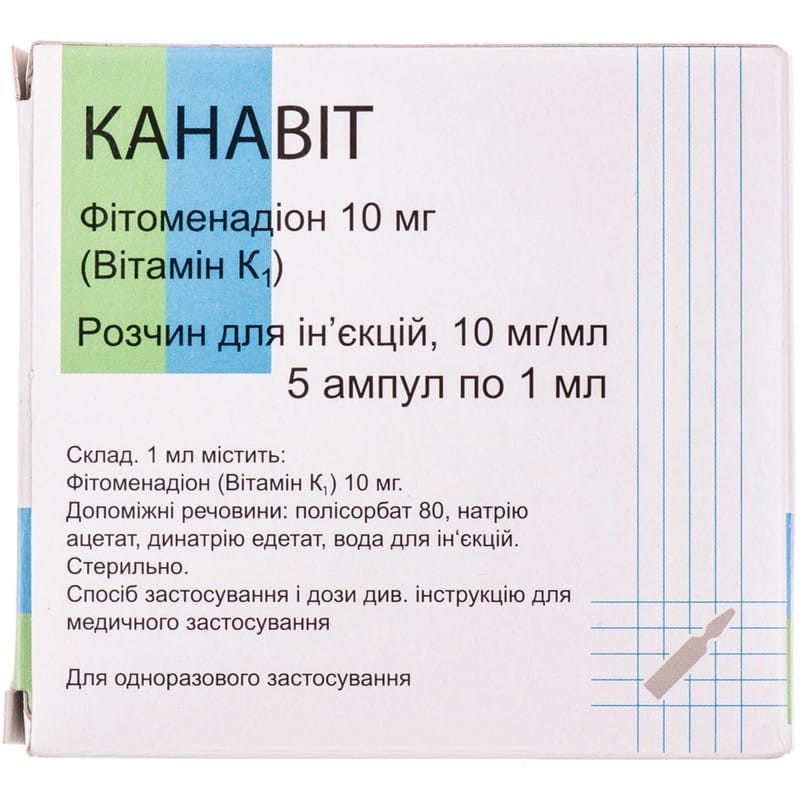



 Secure and encrypted payment processing
Secure and encrypted payment processing We ship to over 40 countries including the USA, UK, Europe, Australia and Japan
We ship to over 40 countries including the USA, UK, Europe, Australia and Japan Guaranteed refund or reship if you haven't received your order
Guaranteed refund or reship if you haven't received your orderVitamin k1 affects the biosynthesis of blood coagulation factors in the liver, namely: factor ii (prothrombin), factor vii (proconvertin), factor ix (Christmass factor) and factor x (stewart factor).
Pharmacokinetics Vitamin K1 after administration it is completely absorbed. It is concentrated in the liver, but does not accumulate in it. Vitamin K Concentration1 in the liver decreases rapidly. A very small amount of vitamin K1 accumulates in tissues and slowly breaks up.
Phytomenadione is rapidly metabolized to polar metabolites, which are excreted in the bile and urine.
Prevention and treatment of bleeding due to reduced blood coagulation associated with vitamin deficiency or vitamin K1 vitamin deficiency.
Treatment of hemorrhagic complications; hypocoagulation after prolonged biliary obstruction and in the early stages of cirrhosis. Gastrointestinal diseases associated with malabsorption after prolonged therapy with antibiotics, sulfonamides and salicylates.
Hemorrhagic phenomena in newborns, uterine bleeding.
In surgical practice with prolonged drainage of the biliary tract and in the preoperative preparation of patients with reduced blood coagulation.
Bleeding after treatment with indirect anticoagulants. adults with severe forms - 10–20 mg (1–2 ampoules) of canavit diluted in 5–10 ml of water for injection or 5% dextrose solution, injected iv slowly. if bleeding does not stop, then after 3-4 hours, repeated administration is allowed. in emergency situations, infusion of fresh blood is mandatory. in mild cases, phytomenadione is administered orally (in the form of drops) or IM in a dose of 10 mg. it must be remembered that the effect of vitamin K1 is long-lasting, especially when used in high doses, and with the simultaneous discontinuation of anticoagulant therapy, it can reach its maximum in 24 hours, when an undesirable increase in blood coagulation is possible and the patient is at risk of thromboembolic complications.
For this reason, it is recommended to be careful and, if possible, to use the drug orally or IM and in low doses to avoid new thromboembolic complications due to the rapid increase in coagulation factors.
Prevention and treatment of bleeding in diseases of the biliary tract and liver. With a slight decrease in blood coagulation factors in adults, 5-10 mg IM 3 times a week are used. With more severe bleeding disorders and with open bleeding, 1-2 ml of IM are used 1-2 times a day until the level of the prothrombin complex is normalized. At the initial stages of liver cirrhosis, 20-30 mg of Canavit is injected IM 3 times a week.
Prevention of bleeding before surgery in patients with reduced levels of coagulation factors. Before urgent surgical intervention in adults, iv 5–20 mg (0.5–2 ampoules) are used; in less urgent cases, i / m 10–20 mg / day 4–6 hours before the planned surgical intervention.
Other bleeding. With a reduced level of factors II, VII and X, with bleeding of various origins, 10–20 mg i / m is used before coagulation correction. The highest single dose is 20 mg, the maximum daily dose of Canavit is 40 mg.
Note. With the on / on application of Canavit, the solution is diluted 1: 5 (with water for injection or 5% solution of dextrose), administered slowly, at a rate of about 1 ml in 20 seconds.
Children. The drug is used in pediatric practice. Canavit is administered to children only in oil.
Bleeding in newborns. Canavit at a dose of 10–20 mg is administered to the woman in labor 48 hours before the expected birth, but no later than 2 hours before the birth, or to the newborn immediately after birth in an oil dose in a dose not exceeding 1 mg. In cases where the newborn is shown the introduction of the drug a second or third time, it is recommended to use phytomenadione in the form of oral drops with milk.
Recommended doses for children.
| Age | Dose mg |
|---|---|
| Newborns | No more than 1 |
| Up to 1 year | 1–2,5 |
| 1-6 years old | 2,5–5 |
| 6-15 years old | 5–10 |
Hypersensitivity to the components of the drug, glucose-6-phosphate dehydrogenase deficiency, hypercoagulation, thromboembolism, hemolytic disease of the newborn, severe liver failure.
Hypersensitivity: rash on the skin.
Reactions at the injection site: inflammation, burning pain.
From the skin and mucous membranes: increased sweating, cyanosis.
From the side of the cardiovascular system: in isolated cases, cardiovascular collapse.
From the respiratory system: bronchospasm.
From the digestive system: hemolytic anemia with def